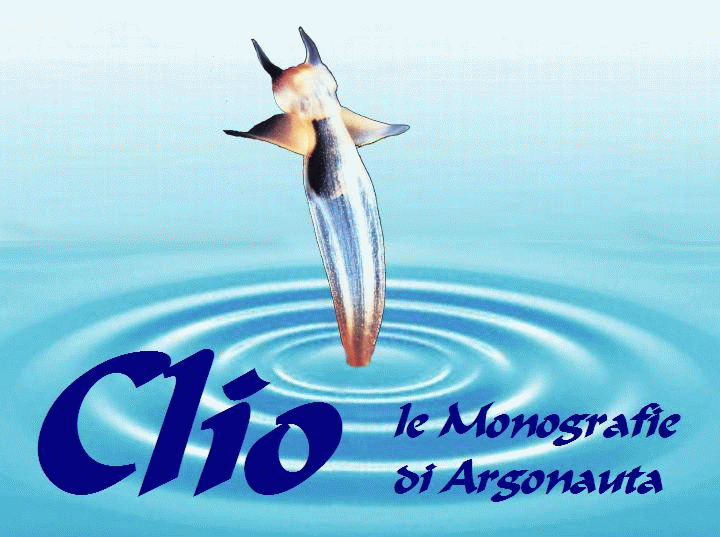
Clio supplemento a Argonauta n. 1-6 2012
 |
 |
THE APORRHAIDAE FAMILY IN THE WORLD
INTRODUZIONELa Famiglia Aporrhaidae Gray, 1850 comprende un piccolo numero di specie suddivise in due generi, con una distribuzione geografica limitata alle sole acque dell'Oceano Atlantico e con estremi limiti di reperimento a Sud, fino alle coste del West Africa; mentre a Nord, in quelle artiche del Canada settentrionale. Nelle acque interne europee è stata segnalata la presenza di Aporrhais pespelecani (Linnaeus, 1758) nel Mar Nero (Bacescu, Muller, Gomoiu, 1971). La presenza di questa specie, come quella di molte altre nel Mar Nero, è legata a particolari fattori di salinità delle acque. Grossu (in litt.) conferma l'assenza di questa specie nelle acque della Romania, nè sotto forma subfossile, nè vivente. Questa specie è ancora reperibile nelle acque del Mar Nero verso la costa orientale dove la salinità appare assai ridotta. La specie è quindi presente in questo mare sulle coste dalla Turchia e in qualche località presso Batum, Georgia (Starobogatov, 1972). La famiglia presenta molte caratteristiche singolari ed interessanti che la legano ai rappresentanti delle Famiglie Strombidae Rafinesque, 1815 , Struthiolariidae Gabb, 1868 per alcuni aspetti tassonomici, mentre per una serie di fattori ecologici e comportamentali, è affine ai rappresentanti della Famiglia Trichotropidae Gray, 1850. Esistono cospicue testimonianze del passato che dimostrano una presenza inequivocabile di questi esseri nel periodo Giurassico (Zittel, 1913 e Cox, 1960) al quale si fa risalire la prima comparsa di forme ancestrali di Aporrhais, per passare poi a periodi successivi dove la presenza di questa specie dimostra una notevole diffusione della famiglia. Tutto ciò appare in evidente contrasto con i «superstiti» attualmente oggi viventi. Le specie considerate valide sono cinque, con qualche varietà spesso dichiarata specie o sottospecie, ma che non trova, a giudizio dell'autore, validità specifica. E' interessante però notare che per quanto concerne la distribuzione verticale della specie, esiste indubbiamente la presenza di ecofenotipi a forte diversificazione morfologica. Hanley (1853) e Sars (1878) danno una distribuzione verticale per l'Aporrhais pespelecani (Linnaeus, 1758) compresa fra i 5 ed i 100 metri; mentre tra gli 80 ed i 300 metri per l'Aporrhais serresiana (Michaud, 1828). Nelle acque settentrionali del Canada sono stati rinvenuti esemplari di A. occidentalis (Beck, 1836) ad una profondità di 360 metri. Clarke (1962) riporta la cattura di alcuni esemplari di questa specie alla profondità di 2000 metri. Recentemente Kantor (2008:51-54) segnala che nel lugio 2007 , lungo le coste di Murman, in località Kislaya Guba Inlet, nella Baia di Motovsk erano stati ritrovati esemplari adulti di A. pespelecani, mentre nell’agosto dello stesso anno veniva rinvenuto un esemplare vivo giovane sempre di A.pespelecani nella Baia di Dalnezelenezkaya . Precedenti ritrovamenti, quale ultimo limite di distribuzione a Nord, erano stati segnalati, nel 1990 a Hayward e Ryland, Norvegia. Queste ultime segnalazioni ampliano di 950 Km. a Nord Est il limite di distribuzione di questa specie. |
INTRODUCTIONThe Family Aporrhaidae Gray, 1850, comprises a small number of species divided into two genera, with a geographical distribution limited to just the waters of the Atlantic Ocean, and is to be found within an area limited to the South by the coast of West Africa, and to the North by the arctic waters of Northern Canada. In internal European waters the presence of Aporrhais pes-pelecani (Linnaeus, 1758) has been reported in the Black Sea (Bacescu, Muller, Gomoiu, 1971). The presence of this species, as with many others in the Black Sea, is related to particular factors of salinity of the waters. Grossu (in litt.) confirms the absence of this species in Rumanian waters, either in sub-fossil form or living. This species is still to be found in the waters of the Black Sea towards the East Coast where the salinity appears much reduced. The species is therefore present in this sea on the coasts of Turkey and in some localities near Batum, Georgia (Starobogatov, 1972). The Family presents many singular and interesting characteristics which relate it to representatives of the Families Strombidae Rafinesque, 1815 and Struthiolariidae Gabb, 1868 for some taxonomic aspects, while for a series of ecological and behavioural factors it resembles representatives of the Trichotropidae Gray, 1850. There is remarkable evidence of the past which demonstrates an unmistakable presence of these beings in the Jiurassic period (Zittel, 1913 and Cox, 1960), in which the first ancestral presence of Aporrhais is traced, to pass in successive periods where the presence of this species shows a notable diffusion of the Family. All this appears in evident contrast to the «survivors» actually living today. The species considered valid are five, with some varieties often declared, species or subspecies, but which in the opinion of the Author, do not have a specific validity. It is interesting to note, however, that as far as the vertical distribution of the species is concerned there is undoubtedly the presence of ecophenotypes with strong morphological diversification Hanley (1853) and Sars (1878) give a vertical distribution for the Aporrhais pespelecani (Linneaeus, 1758) ranging between 5 and 100 metres; while for the Aporrhais serresiana (Michaud, 1828) from 80 to 300 metres. In the northern waters of Canda specimens of A. occidentalis (Beck, 1836) have been found at a depth of 360 metres. Clarke (1962) reports the capture of some examples of this species at a depth of 2000 metres. & nbsp; Recently Kantor (2008:51-54) it signals that in the lugio 2007, along the coasts of Murman, in the place Kislaya Guba Inlet, in the Bay of Motovsk adult samples had been found again of A. pespelecani , while in August of the same year a young alive sample was always recovered of A. pespelecani in the Bay of Dalnezelenezkaya. Precedents recoveries, what last limit of North distribution, had been signalled, in 1990 to Hayward and Ryland, Norway. These last signalings widen of 950 Km. to East North the limit of distribution of this kind. |
